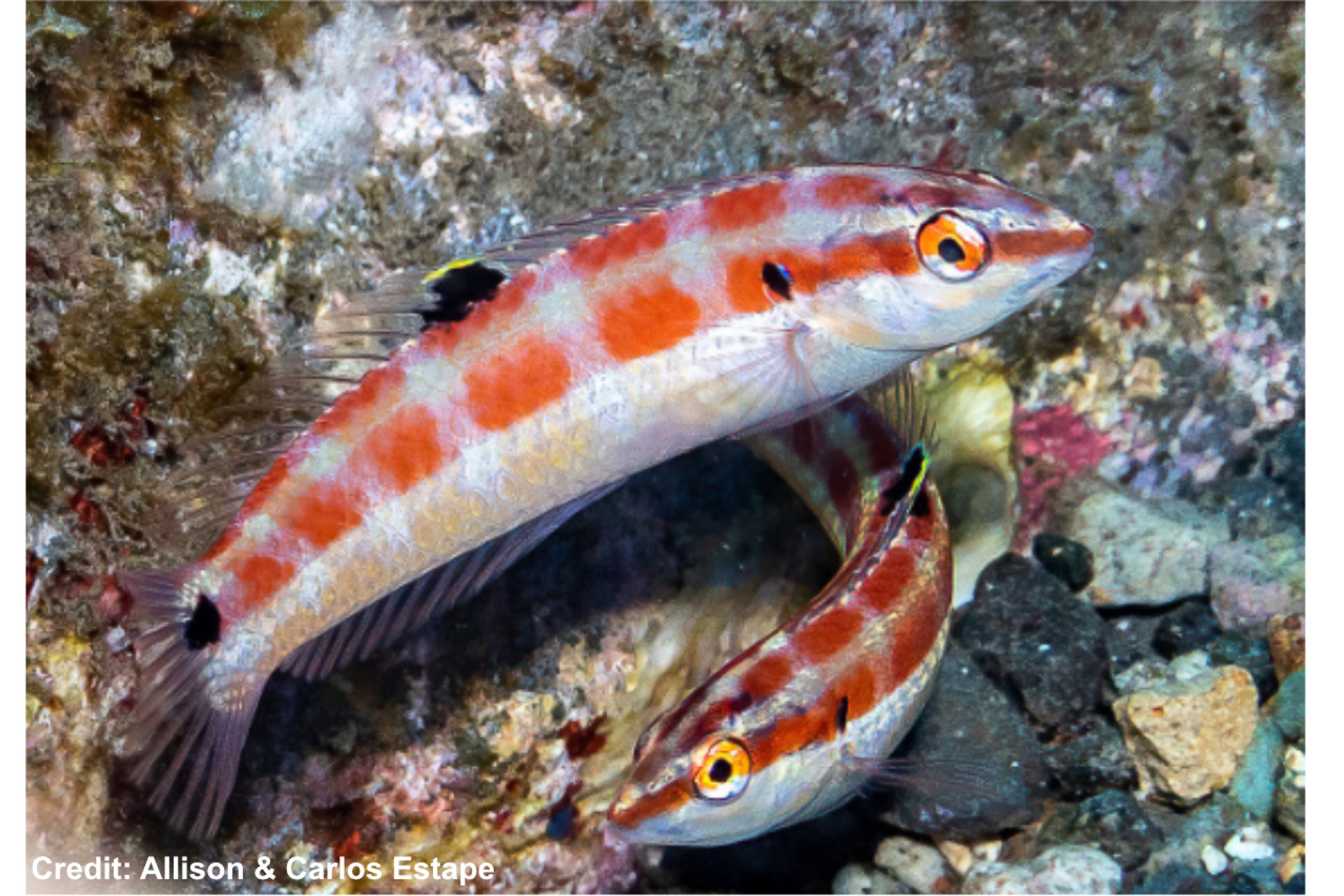NEW FISH SPECIES DISCOVERED AT REMOTE ISLANDS OFF MEXICO’S PACIFIC COAST

A new species of tropical fish, named Halichoeres sanchezi or the Tailspot Wrasse, has been discovered by a team of scientists, including Ben Frable from UC San Diego’s Scripps Institution of Oceanography. The discovery took place during an expedition to the remote islands of the Revillagigedo Archipelago off Mexico’s Pacific coast, renowned for their marine biodiversity. The fish is likely endemic to these islands, meaning it is found nowhere else on Earth. The new species was described in a paper published on Feb. 28 in the journal PeerJ. It was named in honor of marine scientist Carlos Armando Sánchez Ortíz of the Universidad Autónoma de Baja California Sur (UABCS), who collected the first specimen and organized the expedition. The Tailspot Wrasse exhibits sexual dimorphism, with females being mostly white with reddish horizontal stripes, and males displaying an orangy-red coloration fading to a yellow belly with a dark band at the base of the tail. Halichoeres sanchezi belongs to the wrasse family, which comprises over 600 species known for their diversity and vibrant colors, ranging from small species like the Bluestreak Cleaner Wrasse to larger ones like the California Sheephead and Humphead Wrasse, which can reach lengths of seven feet.
Researchers discovered the new wrasse species in
an underwater field of volcanic rubble at a depth of approximately 70 feet near
San Benedicto Island, one of the four islands in Mexico’s Revillagigedo
Archipelago. These islands are situated about 250 miles south of the Baja
California peninsula and 500 miles west of mainland Mexico’s coastline, within
a marine protected area where fishing is prohibited. This protected status,
combined with the islands' remote location, has preserved a rich marine environment
teeming with marine life, including sharks and groupers, which would typically
be heavily exploited in other regions. Despite attracting recreational scuba
divers, the undersea fauna of the Revillagigedo Archipelago remains relatively
understudied compared to more famous archipelagos like the Galapagos. The last
scientific assessment of the islands’ fish diversity occurred over two decades
ago, prompting marine scientists, including Carlos Armando Sánchez and Ross
Robertson, along with underwater photographers Carlos and Allison Estape, to
organize a comprehensive survey of the area's fish diversity in November 2022.
Ben Frable's involvement in the expedition was supported by various funds,
including the Scripps Director’s Office, the Scripps Oceanographic Collections
Fund, and the Lehman-Kennel Endowment for the Scripps Oceanographic Collections.
During an expedition involving an international team of scientists from various institutions, including UABCS, Scripps, the Natural History Museum of Los Angeles County, the Smithsonian Tropical Research Institute, the Ocean Science Foundation, and the University of Central Florida, as well as 11 skilled underwater photographers led by the Estapes, extensive documentation of underwater ecosystems in Mexico’s Revillagigedo Archipelago was conducted. The expedition spanned approximately two weeks, during which the team surveyed all four islands, completing 30 research dives and capturing over 5,500 photographs and 900 specimens representing more than 100 fish species. Tissue samples were collected from all species for DNA analysis, and the specimens are now housed in prestigious collections at Scripps, Mexico’s Colección Nacional de Peces, and the Natural History Museum of Los Angeles County for future research. The expedition's primary objective was to locate a mysterious wrasse species previously photographed in 2013, which appeared distinct from any known species. Despite initial uncertainty, on the last day of the expedition, marine scientist Carlos Armando Sánchez collected a small red fish off San Benedicto Island, later identified as a wrasse and matching the mystery photograph. However, as the specimen was a female, or what scientists term the “initial phase,” the team's goal of fully documenting this potential new species was not yet realized, as male wrasse, referred to as the “terminal phase,” typically exhibit larger and more visually striking appearances to attract females.
During an expedition to the Revillagigedo Archipelago, scientists discovered a new wrasse species. Wrasses are sequential hermaphrodites, meaning they start as females and can become males later. After several unsuccessful attempts, researchers, including William Ludt and Ben Frable, finally collected eight specimens of the species' terminal phase. Subsequent DNA analysis confirmed it as a distinct species, diverging from its closest relatives, the Golden Wrasse from Panama and Redstriped Wrasse from Cocos Island. This discovery brings the tally of endemic fish species in the archipelago to 14, emphasizing the need for continued protection by the Mexican government. Ben Frable expressed awe at finding new species despite regular visitation to the area, highlighting the world's vast complexity. Future publications may reveal two more new species from the expedition's specimens. The participation of skilled underwater photographers was crucial in gathering a wealth of scientific information during the two-week expedition.
During an expedition to the Revillagigedo Archipelago, scientists discovered a new wrasse species. Wrasses are sequential hermaphrodites, starting as females and potentially transitioning to males later. After several attempts, researchers collected eight specimens of the species' terminal phase, led by William Ludt and Ben Frable. Subsequent DNA analysis confirmed it as a distinct species, diverging from its closest relatives, the Golden Wrasse from Panama and Redstriped Wrasse from Cocos Island. This discovery increases the tally of endemic fish species in the archipelago to 14, underscoring the need for continued protection by the Mexican government. Ben Frable expressed amazement at finding new species despite regular visits, showcasing the world's vast complexity. Future publications may unveil two more new species from the expedition's specimens. Skilled underwater photographers played a crucial role in gathering scientific information during the two-week expedition. To learn more go to Alex Fox’s article in Scripps Institution of Oceanography https://scripps.ucsd.edu/news/new-fish-species-discovered-remote-islands-mexicos-pacific-coast